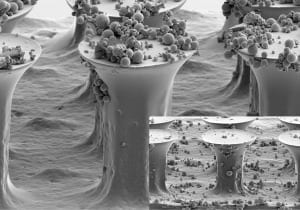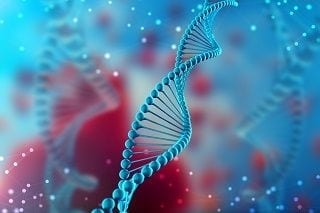
Industry-strength adhesive means products can be dismantled and recycled, rather than thrown into landfill
Researchers at the University of Sussex have developed a glue which can unstick when placed in a magnetic field, meaning products otherwise destined for landfill, could now be dismantled and recycled at the end of their life.
Currently, items like mobile phones, microwaves and car dashboards are assembled using adhesives. It is a quick and relatively cheap way to make products but, due to problems dismantling the various materials for different recycling methods, most of these products will be destined for landfill.
However, Dr Barnaby Greenland, Lecturer in Medicinal Chemistry, working in conjunction with Stanelco RF Technologies Ltd and Prof Wayne Hayes at the University of Reading, may have found a solution.
In a new research paper, published by the European Polymer Journal, Dr Greenland and the team describe a new type of adhesive which contains tiny particles of metal. When passed through an alternating electromagnetic field, the glue melts and products simply fall apart.
The adhesive works with plastic, wood, glass and metal and in terms of strength, is comparable to those currently used in industry.
Dr Greenland said: “In as little as 30 seconds, we can unstick items using a relatively weak magnetic field.
“A power source connected to an inductor creates the electro-magnetic field which produces heat in the metal particles within the glue and effectively melts it so that the various materials that were previously held together are separated.
“There’s little glue residue left over – although this wouldn’t be a problem for metal objects which are melted down for recycling anyway.
“Using these specific levels of magnetic field to heat is also incredibly safe. The energy only heats the metal specks in the glue, so we could place our bare hands in the field and feel absolutely no heat at all.”
In principle, the formula could be applied to any thermal adhesive making it an innovation which could be incorporated into industry relatively easily.
Dr Greenland said: “In essence, we could have a big conveyor belt of products going through a magnetic field where they enter fully assembled, and come out the other end completely dismantled.
“We’re really excited because the glue has provided a simple and green solution to quite a large problem. At the moment, glued products can often only be dismantled using chemicals so not only are we saving items from going to landfill, but we’re also reducing the need to use potentially harmful substances when it comes to getting rid of products.”
The team have also demonstrated that this heating technique can be used to stick items together, and as the project continues, efforts will focus on investigating this process further.
Learn more: Adhesive which debonds in magnetic field could reduce landfill waste
The Latest on: Thermal magnetic adhesive
[google_news title=”” keyword=”thermal magnetic adhesive” num_posts=”10″ blurb_length=”0″ show_thumb=”left”]
via Google News
The Latest on: Thermal magnetic adhesive
- Magnetic with a pinch of hydrogenon April 22, 2024 at 3:34 pm
The challenge was to ensure the stability of the hydrogen-passivated systems in terms of energetic, dynamic and thermal aspects and to determine the correct magnetic state - a task that could only ...
- Magnetic with a pinch of hydrogen: Research team develops new idea to improve the properties of ultra-thin materialson April 22, 2024 at 7:14 am
Magnetic two-dimensional materials consisting of one or a few atomic layers have only recently become known and promise interesting applications, for example for the electronics of the future. So far, ...
- Magnetic with a pinch of hydrogenon April 21, 2024 at 5:00 pm
Twenty years ago, the later Physics Noble Prize winners Konstantin Novoselov and Andre Geim were able to produce a 2D material in a targeted manner for the first time: Using adhesive ... and thermal ...
- Porsche Design HONOR Magic V2 RSR Review: The Ultimate Foldableon March 31, 2024 at 5:00 pm
They use adhesive to stay on ... The Magic V2 RSR also doesn’t really get hot, even in our thermal tests, it faired much better than some other phones. Of course, a big reason for that could ...
- The 9 Best Thermal Curtainson July 14, 2023 at 3:53 am
Once you've hung the curtain, consider sealing it on all sides with Velcro, magnetic tape, or self-adhesive weather stripping to reduce thermal transmittal most-effectively. You can add a valance ...
- MFP-3D-BIO: Optical microscopy for bioscience researchon February 28, 2023 at 9:44 am
The unfolding of fibril amyloid beta-sheets in algal adhesive reveals a distinct sawtooth ... Calibration of the cantilever spring constant using the thermal noise, Sader, or GetReal automated ...
- Regenerative Braking: Everything You Ever Wanted to Knowon June 3, 2021 at 4:59 pm
tooth-like pins instead of an adhesive that’s prone to drying and cracking. The innovative tech is a revolutionary thermal conductor that substantially improves heat transfer effectiveness ...
- Spring Washers Informationon August 15, 2020 at 4:00 pm
These are common in thermal expansion applications ... measurement used to predict a material's load and deflection capability. Copper alloys offer non-magnetic yet electrically conductive washers, ...
- Abrasive Blast Machines and Sandblasters Specificationson February 11, 2018 at 6:26 am
Stripping is the removal of an existing protective coating or paint layer to facilitate welding, recoating or adhesive joining ... high temperature strength, electrical or thermal insulation or other ...
- BEAMing: single-molecule PCR on microparticles in water-in-oil emulsionson July 1, 2006 at 4:59 am
The dual biotin group is essential to keep the oligonucleotide attached to the streptavidin-coated beads during thermal cycling ... of streptavidin-coated magnetic beads 2× with 100 μl of ...
via Bing News










